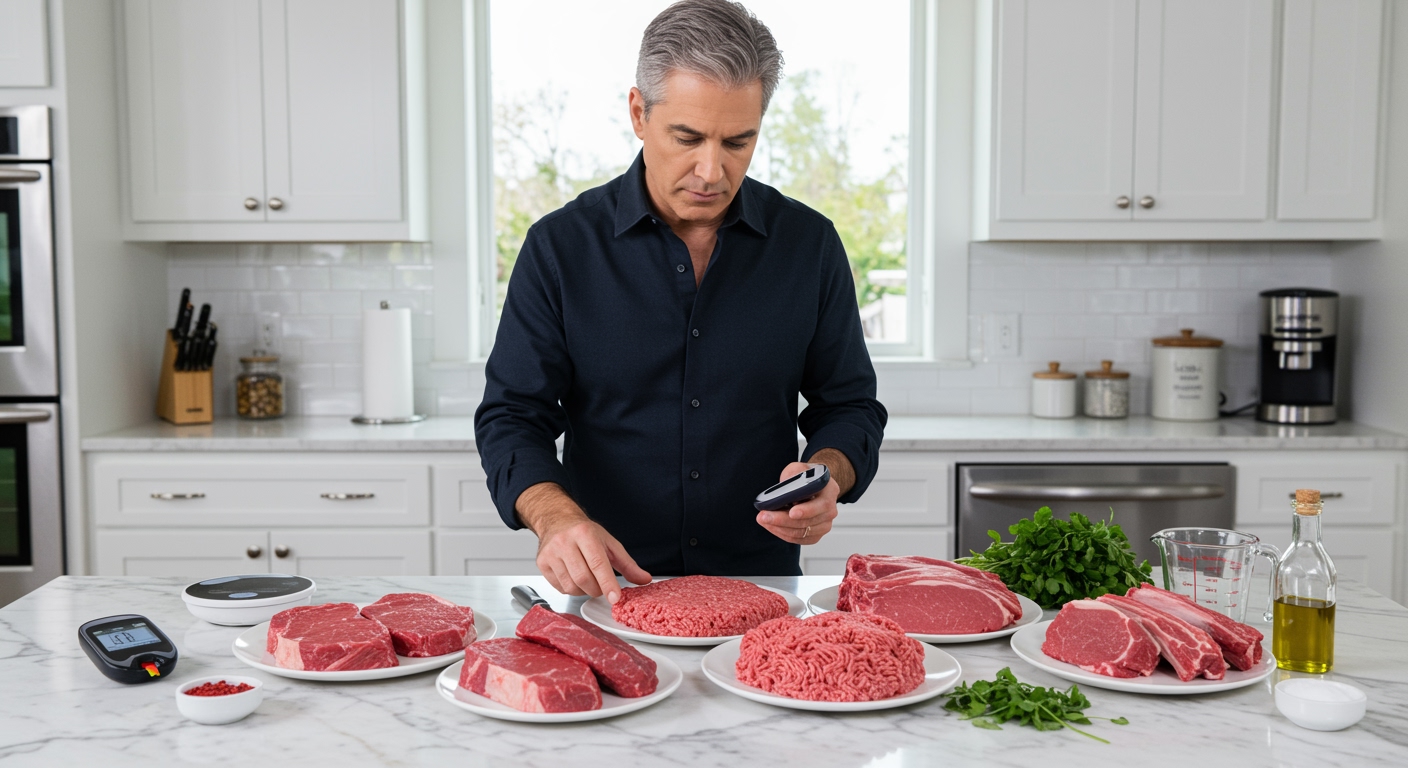✪ Key Takeaway: Red meat can be part of a diabetes diet when eaten in moderation, but processed varieties increase diabetes risk significantly.
Introduction
Your doctor just told you that you have diabetes, and suddenly every food choice feels like walking through a minefield.
You might be wondering if your weekend barbecues and favorite steaks are now off-limits forever, or if red meat will send your blood sugar through the roof.
Hi, I am Abdur, your nutrition coach, and today I am going to explain exactly how red meat affects your blood sugar and whether it belongs in your diabetes management plan.
Does Red Meat Raise Blood Sugar Directly?
Red meat itself does not directly spike your blood sugar levels because it contains virtually zero carbohydrates.
When you eat a plain grilled steak or roasted beef, your blood glucose meter will show minimal immediate changes because protein and fat digest slowly.
However, your body converts some protein into glucose through a process called gluconeogenesis, but this happens gradually over several hours.
The real problem starts when red meat comes with hidden carbohydrates from marinades, sauces, or breading that can cause unexpected blood sugar spikes.
Studies show that lean cuts of red meat have a glycemic index of zero, making them technically safe for immediate blood sugar control.
✪ Pro Tip: Always check marinades and sauces for added sugars that can turn zero-carb meat into a blood sugar bomb.
Can Red Meat Increase Your Diabetes Risk Long-Term?
Research from Harvard School of Public Health reveals that eating processed red meat increases your risk of developing type 2 diabetes by 51 percent.
Processed meats like bacon, sausages, and deli meats contain high levels of sodium, nitrates, and advanced glycation end products that promote insulin resistance.
These compounds trigger chronic inflammation in your body, which interferes with how your cells respond to insulin signals.
Unprocessed red meat shows a smaller but still significant 19 percent increase in diabetes risk when consumed regularly in large portions.
The iron content in red meat, particularly heme iron, may contribute to oxidative stress that damages insulin-producing cells in your pancreas.
Cambridge University research involving over 1.9 million people confirms that even modest increases in red meat consumption correlate with higher diabetes rates across different populations.
✪ Fact: Replacing one serving of red meat daily with nuts reduces diabetes risk by 21 percent according to major studies.
What Makes Some Red Meat Worse Than Others?
The way red meat is processed and prepared makes an enormous difference in how it affects your metabolic health.
Processed varieties undergo curing, smoking, or chemical preservation that creates harmful compounds like nitrosamines and polycyclic aromatic hydrocarbons.
These chemicals interfere with your body’s natural insulin sensitivity and promote inflammation that worsens glucose metabolism.
High-temperature cooking methods like grilling or frying create additional toxic compounds called heterocyclic amines that further damage your insulin-producing cells.
Fresh, lean cuts of red meat cooked at lower temperatures through methods like braising or slow roasting pose significantly less risk.
Grass-fed beef contains higher levels of omega-3 fatty acids and antioxidants compared to grain-fed varieties, which may offer some protective benefits.
✪ Note: Marinating meat in herbs and spices before cooking can reduce harmful compound formation by up to 90 percent.
How Much Red Meat Is Safe For Diabetics?
The American Diabetes Association suggests limiting red meat to two servings per week for optimal blood sugar management.
One serving equals about 3 ounces of cooked meat, which is roughly the size of a deck of cards or the palm of your hand.
Research shows that people who eat less than one serving of red meat per week have the lowest rates of diabetes complications and cardiovascular problems.
When you do choose red meat, prioritize lean cuts like sirloin, tenderloin, or 95 percent lean ground beef to minimize saturated fat intake.
Pairing red meat with high-fiber vegetables and whole grains can help slow digestion and prevent any potential blood sugar fluctuations.
Consider replacing some red meat meals with fish, poultry, legumes, or plant-based proteins to diversify your nutrient intake and reduce diabetes risk.
✪ Pro Tip: Track your blood sugar response to different red meat portions to find your personal tolerance level.
The Bottom Line
Red meat can fit into a diabetes management plan when consumed mindfully and in moderation, but it should not be your primary protein source.
Smart food choices today create the foundation for stable blood sugar tomorrow, and this principle applies especially to how you approach red meat in your diet.
I would love to hear about your experiences with red meat and blood sugar management, so please share your questions or observations in the comments below.
References
At NutritionCrown, we use quality and credible sources to ensure our content is accurate and trustworthy. Below are the sources referenced in creating this article:
- PMC: Red meat consumption and risk of type 2 diabetes
- Harvard School of Public Health: Red meat consumption associated with increased type 2 diabetes risk
- University of Cambridge: Red and processed meat consumption associated with higher type 2 diabetes risk
- January AI: Glycemic Index of Red Meat





